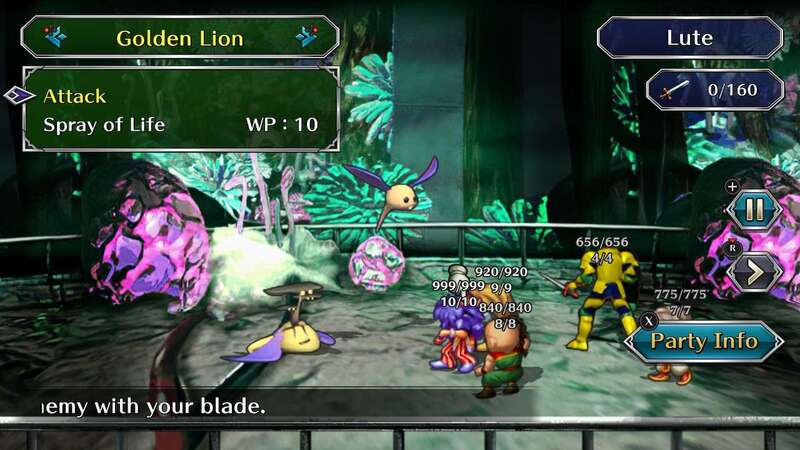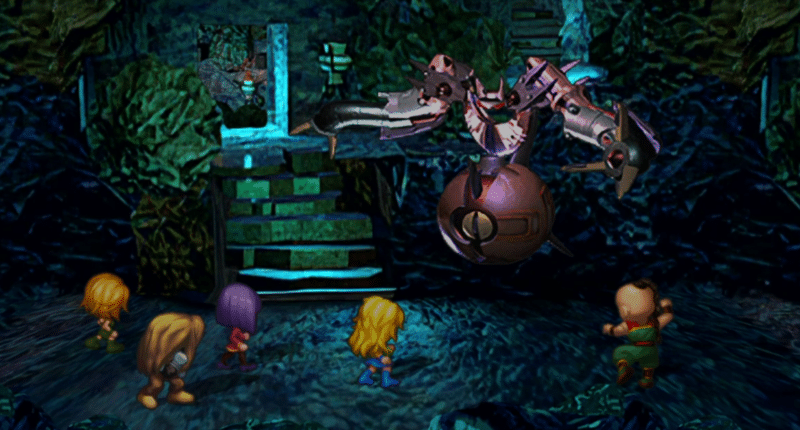SaGa Frontier originally debuted on the Sony PlayStation in Japan on July 11, 1997. A port later came to North America on March 24, 1998. It was the seventh title in its series, but the first outside Japan to use the “SaGa” branding. Coming off the trails of the Romancing SaGa trilogy, SaGa Frontier was set to make a big splash on a powerful, new console. But what makes it such a fascinating game?
SaGa Frontier’s Story
To provide context, SaGa Frontier was released about half a year after Final Fantasy VII came out. Juxtaposing this tandem is not unusual, as the two were simultaneously developed by Square and share many commonalities. Both games represented a liminal shift that had occurred in RPGs—and video games at large—during that time, both mechanically and in terms of storytelling. The 90s era was defined by counterculture, which seeped into the gaming landscape. Hackneyed JRPG tropes of yesteryear remain something of a litany: a plucky kid chosen by destiny, heroic rebels fighting against an evil empire, magical crystals, and so forth. Contemporary games still find difficulty escaping the gravitational pull of these banalities.
SaGa Frontier largely shies away from these conventions. Not all of its heroes are do-gooders wanting to thwart dastardly villains, though, in fairness, that is essentially Red’s scenario. Some of its heroes, like Lute, are just bumbling fools traipsing into danger. Other adventures, especially Asellus’s, are transgressive, even bizarre. Likewise, Final Fantasy VII was also helmed by protagonists who broke from the established norm. To observe these nonconformal qualities, it would be worthwhile to further examine each of SaGa Frontier‘s eccentric cast members and their respective backdrops.
SaGa Frontier’s Characters
The original SaGa Frontier features 7 diverse main characters. Each one has a unique storyline and gameplay mechanics. Allies that can be recruited also differ depending on which hero’s story you tackle. Many of them can even enlist other main characters in their scenarios. Here is a comprehensive list of the 7 player characters:
Asellus
Asellus is a human girl transformed into a Half-Mystic via blood transfusion after being trampled by a carriage. She rebels against her captor, Lord Orlouge, and mounts a mutiny to overthrow his reign over Facinaturu. Asellus’s story has multiple endings that diverge on whether she embraces her newfound Mystic abilities and identity.
Blue
Blue is a fledging mage who has just concluded his schooling in the Magic Kingdom. During his graduation ceremony, he is tasked with mastering all the schools of Magic. Blue’s raison d’être is to slay his brother, Rouge, and discover the meaning behind his birth.
Red
Perhaps the most traditional of the main party members, Red is a teenager bequeathed superpowers by the masked hero Alkarl. His shonen-esque plot follows him as he must foil the machinations of an evil syndicate called Black X. He must hunt and defeat Black X’s 4 head honchos before confronting the man who destroyed his family.
Emilia
Emilia is a ditzy, blonde supermodel falsely accused of the murder of her fiance, Ren. After escaping the prison of Despair, she joins a clandestine group known as Gradius and performs missions with them in the hopes of uncovering the sinister Joker. With each successful outing, Emilia slowly unravels what happened on the night Ren was killed and Joker’s involvement.
Lute
Lute is an empty-headed bard kicked out of his mother’s nest for refusing to find a job. Lute’s journey pushes him to seek out the truth of his father’s demise and face the calculating General Mondo. His is the shortest journey, but also the most open in terms of exploration.
Riki
Riki is a cutesy, green Lummox who must collect magical Rings to save his dying planet of Margmel. Along the way, he encounters the enigmatic Mei-Ling, who has a strange transfixion with the Rings and lends him her aid in his quest.
T260
T260 is an ancient Mec that lost its memory following a large-scale space battle. T260 crashes into the world of Junk and is awoken by a young boy named Thyme. T260 befriends Thyme, his older sister Rose, and their uncle Taco, an anthropomorphic octopus educated in engineering. It later departs Junk, venturing forth to recalibrate its memory and fulfill its secret mission.
To quote Rufus from FF7, “What a crew.” This motley cast of misfits leaves an indelible mark on players years after SaGa Frontier’s release. Asellus’s nuances and sexuality are still a topic of discussion. Amongst the allies that can be befriended are some notable personalities. One of the more prominent is Gen, a wino-samurai who functions as the deuteragonist in T260’s path. Fuse, a hotheaded IRPO agent, can be recruited in every scenario, even Emilia’s which involves a brutal interrogation over the death of his colleague, Ren. It is a strange assembly of personalities, some more cryptic than others. How each of them operates in battle is also an interesting topic.
SaGa Frontier’s Gameplay

The SaGa series is unique compared to other JRPGs. Previous titles were marketed using Final Fantasy’s established brand (e.g. Final Fantasy Legend, Final Fantasy Legend II). This was somewhat of a misnomer as the gameplay of SaGa titles contrasts markedly with Final Fantasy. Rather than emphasize linear storytelling and deep characterization, SaGa games focus on branching choices and exploring open worlds. SaGa Frontier, likewise, is about choice, even if it disrupts a cohesive narrative.
Characters do not level up; instead, they have a random chance to gain stats after battle depending on the player’s actions, similar to Final Fantasy II. SaGa Frontier contains myriad hidden mechanics and a large roster of characters, rivaled by games like Chrono Cross. New techniques are gained incrementally through a process called “Glimmering.” These facets of the game can make a playthrough haphazard. But it is also quite personalized and exciting. Launching a brand new technique acquired during the heat of combat is thrilling. The player will have plenty of opportunities to gain these skills as they explore SaGa Frontier’s plethora of Regions.
Regions
SaGa Frontier does not opt for the stock medieval-adjacent setting seen in most of the RPGs that preceded it. Instead, the game’s world is a unique science fantasy environment separated by “Regions.” Each Region can be considered a separate planet of sorts, though it is unclear in the game how distant they are from one another. On each world, the player can find a port that allows for quick travel between Regions. The type of ship departed on will even alter depending on which Region the player is currently traversing. This allows for a logical take on the gamut of disparate environments generally expected in the JRPG genre.
The Regions of the game are where much of SaGa Frontier’s subtle worldbuilding is evident. On each planet dwells varying peoples, races, and cultures. Some Regions devote themselves to learning Magic, such as the fittingly named Magic Kingdom. Others focus on futuristic industries, such as Manhattan. The aptly titled Baccarat is a city dedicated to gambling and casinos, covertly controlled by gnomes. Within these Regions, monsters, humans, and robots coexist in distinct ways. There is a strange admixture of esoteric mysticism and advanced technology infused throughout these worlds that is quite intriguing. These areas are easily accessible too, thanks to the Free Scenario System.
The Free Scenario System
Perhaps one of the more divisive and ambitious elements of SaGa Frontier is its “Free Scenario System.” Effectively this meant that each scenario would gradually open up and allow the player to explore the game’s Regions without restraint. In modern parlance, we would refer to this as an “open world” game. This was a relatively novel concept at the time for a JRPG. This freedom is not without its drawbacks. Due to the purposely designed open nature of the game, the story can often be gaunt. Sometimes characterization and relationships develop rather suddenly.
Some background information and plot points are never fully explored. Emilia’s story touches on the existence of an enigmatic object called Cube. It is never explained precisely what Cube is, though some interviews with the Director would be illuminating. This sparseness could frustrate some players. But there is something to be said for allowing us to connect dots in our heads. Not everything needs to be explained in laborious detail. Some things can be left to our imagination. It is worth noting that like many other titles produced during its time, SaGa Frontier suffered from a rushed development. Deadlines to push out a completed product are likely alien to our current environs where incremental updates are the norm.
The SaGa Continues

When SaGa Frontier was first released, it amassed decent reviews from critics and magazines. Gamers were more polarizing in their sentiments. The Romancing SaGa titles for the SNES were never localized, so Frontier likely caused whiplash in players due to what was generally expected in a JRPG. But veterans of the genre can appreciate its complexity and freedom. What makes it different is also what makes it good. The unfamiliar setting may have been too stark, which is why SaGa Frontier 2 harkened to the medieval roots from which previous titles drew. The sequel did not have the original’s hefty troupe of characters and somewhat scaled back the Free Scenario System, providing comparatively more linear storytelling.
A remaster of SaGa Frontier was released on April 15, 2021, for mobile devices, the Nintendo Switch, PlayStation 4, and PC. This remaster reintroduced the game to a new generation; it also restored some lost content. Fuse, formerly a minor character, was granted his own story scenario that provides more context to the other main cast members. Some cut sidequests and decisions, most notably in Asellus’s journey, were also revived in the remaster. SaGa Frontier 2 is also set to receive a makeover on the horizon, though this may have been an unintentional reveal. SaGa fans will be anticipating what this treatment of the sequel will bring to an outlandish and wonderful series.
For More Great Content
Are you desiring top-tier content that covers everything? From thrilling sports and intoxicating entertainment news to gaming tips and professional betting advice, Total Apex covers it all. Delve into our no-fluff articles to stay ahead of the game with the latest sports action, uncover the hottest trends in entertainment, and get the latest scoops in the gaming industry that will take your experiences to the next level.
Finally, our betting advice will give you a decisive edge over the competition and increase your odds of beating the books. Whether you’re looking to stay updated or gain a competitive edge, Total Apex is your one-stop shop for all things compelling and relevant. Don’t forget we cover Fantasy Sports, too!
Check out all our sites: Total Apex Sports, Total Apex Fantasy Sports, Total Apex Entertainment, Total Apex Sports Bets, and Total Apex Gaming. Out of the ashes of obscurity will rise a beast. Always remember to Respect The Hustle! Follow us on Twitter/X @TotalApexSports to stay informed.

